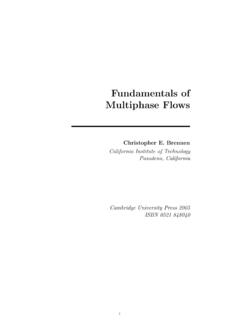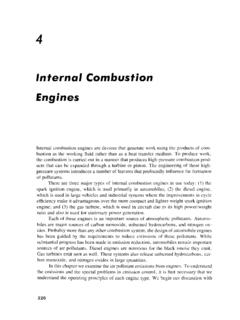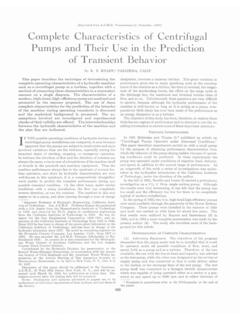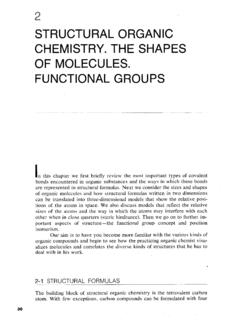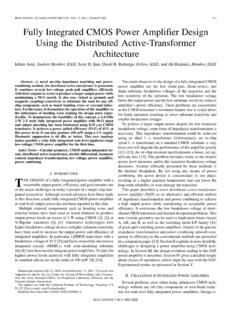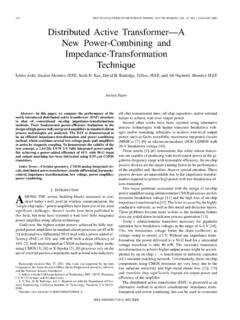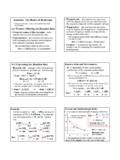Transcription of Heterogeneous Catalysis - CaltechAUTHORS
1 _ _~---=---5. Heterogeneous Catalysis I Introduction Catalysis is a term coined by Baron J. J. Berzelius in 1835 to describe the property of substances that facilitate chemical reactions without being consumed in them. A. broad definition of Catalysis also allows for materials that slow the rate of a reac- tion. Whereas catalysts can greatly affect the rate of a reaction, the equilibrium com- position of reactants and products is still determined solely by thermodynamics. Heterogeneous catalysts are distinguished from homogeneous catalysts by the dif- ferent phases present during reaction. Homogeneous catalysts are present in the same phase as reactants and products, usually liquid, while Heterogeneous catalysts are present in a different phase, usually solid.
2 The main advantage of using a hetero- geneous catalyst is the relative ease of catalyst separation from the product stream that aids in the creation of continuous chemical processes. Additionally, heteroge- neous catalysts are typically more tolerant of extreme operating conditions than their homogeneous analogues. A Heterogeneous catalytic reaction involves adsorption of reactants from a fluid phase onto a solid surface, surface reaction of adsorbed species, and desorption of products into the fluid phase. Clearly, the presence of a catalyst provides an alter- native sequence of elementary steps to accomplish the desired chemical reaction from that in its absence. If the energy barriers of the catalytic path are much lower than the barrier(s) of the noncatalytic path, significant enhancements in the reaction rate can be realized by use of a catalyst.
3 This concept has already been introduced in the previous chapter with regard to the CI catalyzed decomposition of ozone (Figure ) and enzyme-catalyzed conversion of substrate (Figure ). A sim- ilar reaction profile can be constructed with a Heterogeneous catalytic reaction. For example, G. Ertl ( Catalysis : Science and Technology, 1. R. Anderson and M. Boudart, Eds., vol. 4, Springer-Verlag, Berlin, 1983, p. 245) proposed the ther- mochemical kinetic profile depicted in Figure for the platinum-catalyzed oxidation of carbon monoxide according to the overall reaction CO + O 2 =} CO 2 , The first step in the profile represents the adsorption of carbon monoxide and 134 chapter 5 Heterogeneo!
4 Js Catalysis .. ~. +. ++ ;, CO(g) O(g).. +. +.. / 249 : .. 1". CO(g) + "2 0 z ( g ) . ,~., ..-.'..!:.~". : . ,,---_.,"- '.._--"".,,"',", : . _,~-_ ..,- . 259 ~H = 283.. +. 105 +. +.+. COz(g). CO Zads -21. Figure I. Schematic energy diagram for the oxidation of CO and a Pt catalyst. (From data presented by G. Ertl in Catalysis : Science and Technology, J. R. Anderson and M. Boudart, Eds., vol. 4, Springer-Verlag, Berlin, 1983, p. 245.) All energies are given in kJ mol-I. For comparison, the heavy dashed lines show a noncatalytic route. dioxygen onto the catalyst. In this case, adsorption of dioxygen involves dissocia- tion into individual oxygen atoms on the Pt surface. The product is formed by ad- dition of an adsorbed oxygen atom (Oads) to an adsorbed carbon monoxide mole- cule (CO ads )' The final step in the catalytic reaction is desorption of adsorbed carbon dioxide (C0 2 ads) into the gas phase.
5 The Pt catalyst facilitates the reaction by pro- viding a low energy path to dissociate dioxygen and form the product. The noncat- alytic route depicted in Figure is extremely slow at normal temperatures due to the stability of dioxygen molecules. VIGNETTE chapter 5 HeterogeneolJs Catalysis 135. 136 chapter 5 HeterogeneolJs Catalysis Since the number of atoms on the surface of a bulk metal or metal oxide is ex- tremely small compared to the number of atoms in the interior, bulk materials are often too costly to use in a catalytic process. One way to increase the effective sur- face area of a valuable catalytic material like a transition metal is to disperse it on a support.
6 Figure illustrates how Rh metal appears when it is supported as nanometer size crystallites on a silica carrier. High-resolution transmission electron microscopy reveals that metal crystallites, even as small as 10 nm, often expose the common low-index faces commonly associated with single crystals. However, the surface to volume ratio of the supported particles is many orders of magnitude higher than an equivalent amount of bulk metal. In fact, it is not uncommon to use cata- lysts with I nm sized metal particles where nearly every atom can be exposed to the reaction environment. Estimation of the number of exposed metal atoms is rather straightforward in the case of a single crystal of metal since the geometric surface area can be mea- sured and the number density of surface atoms can be found from the crystal structure.
7 chapter 5 HeterogeneolJs Catalysis 137. (a). (b). Figure I. (a) Rhodium metal particles supported on silica carrier. (b) High-resolution electron micrograph shows how small supported Rh crystallites expose low-index faces. (Top photo courtesy of A. K. Datye. Bottom photo from "Modeling of Heterogeneous catalysts using simple geometry supports" by A. K. Datye in Topics in Catalysis , vol. 13:131, copyright 2000 by Kluwer Academic, reproduced by permission of the publisher and the author.). 138 chapter 5 HetemgeneolJs Catalysis For supported metal catalysts, no simple calculation is possible. A direct mea- surement of the metal crystallite size or a titration of surface metal atoms is required (see Example ).
8 Two common methods to estimate the size of supported crys- tallites are transmission electron microscopy and X-ray diffraction line broadening analysis. Transmission electron microscopy is excellent for imaging the crystallites, as illustrated in Figure However, depending on the contrast difference with the support, very small crystallites may not be detected. X-ray diffraction is usually ineffective for estimating the size of very small particles, smaller than about 2 nm. Perhaps the most common method for measuring the number density of exposed metal atoms is selective chemisorption of a probe molecule like Hz, CO, or Oz. Selective chemisorption uses a probe molecule that does not interact significantly with the support material but forms a strong chemical bond to the surface metal atoms of the supported crystallites.
9 Chemisorption will be discussed in more detail in Sec- tion Dihydrogen is perhaps the most common probe molecule to measure the frac- tion of exposed metal atoms. An example of Hz chemisorption on Pt is shown below: Pt atom H. 2 Ptsurface + H2 ==> 2 PtsurfaceH. The exact stoichiometry of the Pt-H surface complex is still a matter of debate since it depends on the size of the metal particle. For many supported Pt catalysts, an as- sumption of 1 H atom adsorbing for every 1 Pt surface atom is often a good one. Results from chemisorption can be used to calculate the dispersion of Pt, or the frac- tion of exposed metal atoms, according to: 2 X (Hz molecules chemisorbed). Fraction exposed = Dispersion = fP.
10 Total number 0 t atoms If a shape of the metal particle is assumed, its size can be estimated from chemisorp- tion data. For example, a good rule of thumb for spherical particles is to invert the dispersion to get the particle diameter in nanometers: 1. Particle diameter (nm) = .. DIspersIOn Table compares the average diameter of Pt particles supported on alumina determined by chemisorption of two different probe molecules, X-ray diffraction, and electron microscopy. The excellent agreement among the techniques used to chapter 5 Heterogeneolls Catalysis 139. Table I Determinationof metal particle size on Pt/AI 2 0 3 catalysts by chemisorption of H2 and CO, X-ray diffraction, and transmission electron microscopy.

